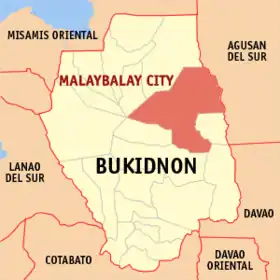Malaybalay
Malaybalay est une ville de 1re classe, capitale de la province de Bukidnon, aux Philippines.
| Malaybalay (fil) Lungsod ng Malaybalay (ceb) Dakbayan sa Malaybalay | ||
 Capitole de la province de Bukidnon | ||
| Administration | ||
|---|---|---|
| Pays | ||
| Région | Mindanao du Nord | |
| Province | Bukidnon | |
| Barangays | 46 | |
| Maire | Ignacio W. Zubiri | |
| Code postal | 8700 | |
| Démographie | ||
| Population | 153 085 hab. (2010) | |
| Densité | 156 hab./km2 | |
| Géographie | ||
| Coordonnées | 8° 09′ 16″ nord, 125° 07′ 42″ est | |
| Altitude | 622 m |
|
| Superficie | 98 438 ha = 984,38 km2 | |
| Localisation | ||

| ||
| Géolocalisation sur la carte : Philippines
| ||
| Liens | ||
| Site web | http://www.malaybalaycity.gov.ph | |
La ville compte 153 085 habitants en 2010.
Barangays
Malaybalay est divisée en 46 barangays :
- Aglayan
- Bangcud
- Busdi
- Cabangahan
- Caburacanan
- Can-ayan
- Capitan Angel
- Casisang
- Dalwangan
- Imbayao
- Indalasa
- Kalasungay
- Kibalabag
- Kulaman
- Laguitas
- Patpat
- Linabo
- Apo Macote
- Miglamin
- Magsaysay
- Maligaya
- Managok
- Manalog
- Mapayag
- Mapulo
- Barangay 1
- Barangay 2
- Barangay 3
- Barangay 4
- Barangay 5
- Barangay 6
- Barangay 7
- Barangay 8
- Barangay 9
- Barangay 10
- Barangay 11
- Saint Peter
- San Jose
- San Martin
- Santo Niño
- Sila-e
- Simaya
- Sinanglanan
- Sumpong
- Violeta
- Zamboanguita
Démographie
| Année | Habitants | Évolution |
|---|---|---|
| 1918 | 16 428 | - |
| 1939 | 18 816 | 14,54 % |
| 1948 | 16 458 | -12,53 % |
| 1960 | 32 522 | 97,61 % |
| 1970 | 47 074 | 44,75 % |
| 1975 | 65 198 | 38,50 % |
| 1980 | 60 779 | -6,78 % |
| 1990 | 94 790 | 55,96 % |
| 1995 | 112 277 | 18,45 % |
| 2000 | 123 672 | 10,15 % |
| 2007 | 144 065 | 16,49 % |
| 2010 | 153 085 | 6,26 % |
- Portail des Philippines
Cet article est issu de Wikipedia. Le texte est sous licence Creative Commons – Attribution – Partage à l’identique. Des conditions supplémentaires peuvent s’appliquer aux fichiers multimédias.
